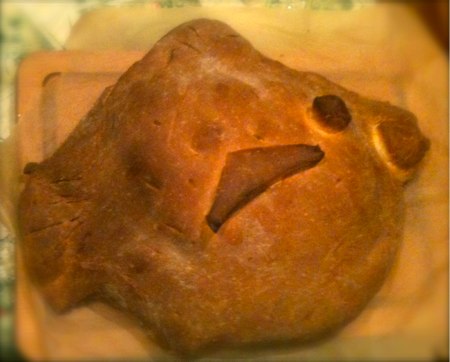Chocolate and Danger

An old friend was coming to dinner after a nasty bicycle accident and surgery. She doesn’t eat meat or cheese. It’s too late in the year for really great vegetables.
- Red Alert! red pepper and sumac soup with lemon yogurt, onion focaccia with cranberry ginger chutney
- White on white.Celery root remoulade, with small chunks of home-smoked haddock.
- We’re really in hot soup now! Homemade pumpkin ravioli in fennel broth, garnished with strange mushrooms
- Foods that even Julia Child cannot pronounce right/From cookbooks that time has forgot. Coulibac of salmon with mushroom duxelles and quinoa, with baby brussels sprouts, balsamic peppers, and cilantro aioli
- Salad.
- Will Robinson Apple crisp
- You’re a brick! Chocolate pavé
- Where there’s smoke… Smoked pistachio brittle
- Fire! Clotilde’s fiery chocolate biscuits
The real danger is that we’ve only got two substantial courses – the ravioli and the coulibac – and both are going to be high-wire acts: I’ve never done them before, they require assembly, and both are prone to spectacular failure at the last moment.
Would the coulibac turn into mush or crumble to bits? Would the ravioli disintegrate? And what about Naomi?
Oh dear.
The coulibac is something I’ve thought about for eons. It was in Julia Child’s Cooking for Company
, which I got in graduate school and which is a silly book from which to learn to cook. Someone really should have told me to get The Art Of French Cooking or to get something sensible. But there it is, and plenty of people on the net will lend a hand with updates and suggestions.
You’ve seen the dish in Julie & Julia, but for some reason (oh woe!) I can’t find Julie Powell’s old blog anywhere and so can’t like to her triumphal version.
The idea is to bake a fish in a bread crust. It’s a Russian dish by way of Escoffier, which explains the whimsical name and the extravagant concept, not to mention the idea of making a pastry that looks like a funny fish and that has a fish inside it.
Here’s what you do:
- Make a big batch of brioche the night before, so the dough can ferment in the refrigerator and then rise all morning. The dough can enjoy this leisurely rise, since it is resting luxuriously in your two best mixing bowls, which leaves the focaccia to rise in your inferior mixing bowl and the rest of the meal to be prepped in castoffs, strays, storage containers, and other concave things.
- Make two pounds of mushroom duxelles. This is not really enough.
- Make a cup of quinoa, which you toast before cooking. Nobody said whether you wanted a cup before or after it was cooked, but 1c uncooked quinoa was really more than I needed. Otherwise, the inadequate mushroom duxelles might be lost entirely.
- Season and sear the fish very quickly, so it doesn’t cook but colors well.
- Make a very big crepe. Julia wants one the size of a jelly roll pan, but I settled for one the size of the griddle. Nobody really explains why the crepe is there or what it’s for. It’s Escoffier.
- Not long before dinner, you roll out the dough in two flat sheets. You can’t do this too far in advance or the dough won’t be right. You cut the dough into fish shapes. On the bottom, you layer the crepe, the mushrooms, the quinoa, and the fish. You fold the crepe over to make a fun little envelope.
- Then you lower the top crust, seal, and trim it. And use the trimmings to sculpt cute fish details. And you are supposed to carve little scales into the crust. This reminds you that should have been paying attention in 3rd grade, which is probably the last time anyone told you to make a sculpture of a fish.
- Bake and serve at once, leaving everyone hungry if something goes wrong.
It was actually pretty good, and now I understand where it’s headed. Julia adds an odd mixture of fish (I was going to use smoked haddock) and paté de choux, and now I think that would work well. Note to future: season the interior aggressively. I think it would be better if it were served, as originally intended, with lots of Hollandaise. But Hollandaise is pretty in-your-face with egg and butter. Since Ruhlman says a Hollandaise can smell fear, discretion and aioli seemed the better part of valor.
The chocolate pavé from Alice Waters’s Simple Food
is not really all that simple, but it’s very good. A smidgeon of smoked pistachio brittle gives you a changeup and another crack at the fire. And if anyone thinks it a trifle rich, they can top it with one of Clotilde’s biscuits trés chocoloates with Valrohna chocolate, cocoa powder, cocoa nibs, and a nice dollop of fiery anchos for a kick